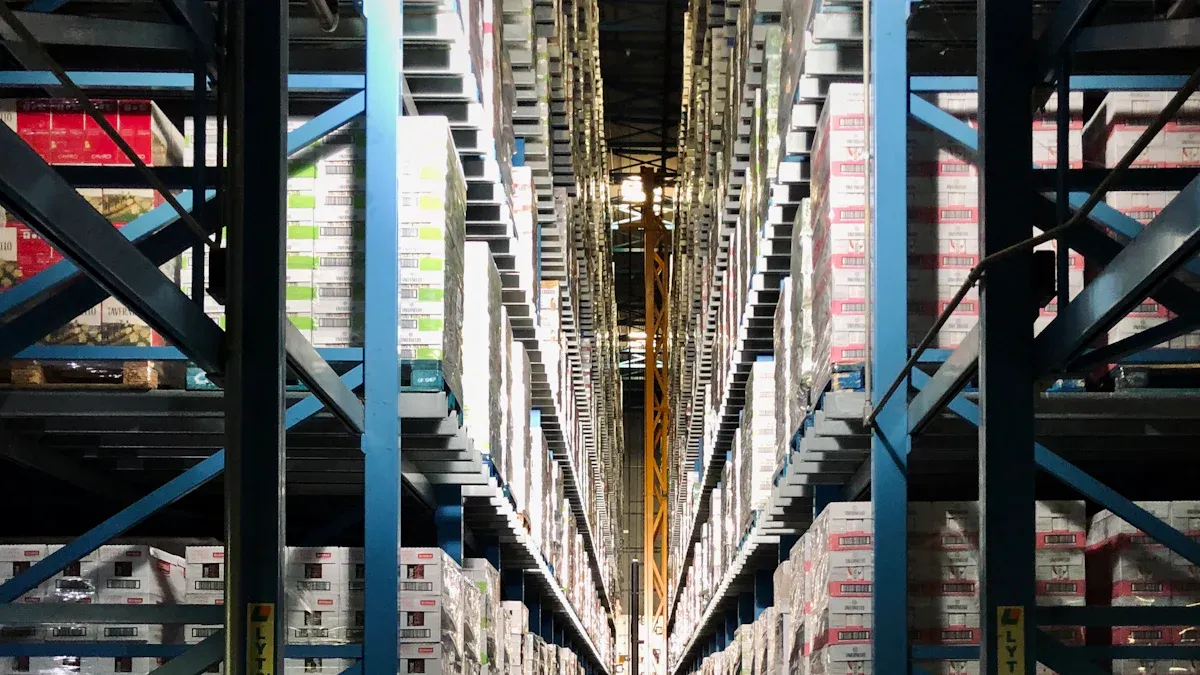Global Demand for Nitinol Tubing and Its Supply Chain Risks

Nitinol tubing, a blend of nickel and titanium, is unique because it can remember shapes and bend easily. Many industries, including healthcare, airplanes, and robots, rely on it. Hospitals require Nitinol tubing quickly to assist patients. However, the Nitinol tubing production capacity often struggles to keep up with demand. Regulations and limitations further hinder production. To address this, suppliers are utilizing smart tools such as tracking and data predictions, which help them overcome challenges and enhance their Nitinol tubing production capacity to meet the needs of various sectors.
Key Takeaways
Nitinol tubing is special because it can remember shapes. This makes it great for flexible and strong uses in healthcare and airplanes.
More people want Nitinol tubing because it helps in medical tools. This creates chances for growth in new markets.
Problems like low production and few makers can slow supply.
Companies can make more by using better machines and teaming up with suppliers. This helps keep materials coming steadily.
Finding new materials and recycling can lower costs. It also makes the supply chain for Nitinol tubing stronger.
Factors Driving the Nitinol Tubing Market

Unique Properties and Benefits of Nitinol Tubing
Nitinol tubing is special because it can return to its shape. This makes it great for things needing flexibility and strength. It can handle a lot of stress without breaking or staying bent. This is very important for healthcare and airplane industries. Nitinol is also safe to use in the body, so it’s popular for medical tools.
Studies show it lasts longer than other materials. For example, TM-1 materials are the best at resisting wear and tear. This means Nitinol tubing can be used many times in tough jobs, like surgeries. These features make Nitinol tubing highly wanted in many industries.
Role of Nitinol in the Medical Devices Market
The use of Nitinol in medical tools has grown quickly. It works well for small surgeries because it bends easily and is safe for the body. It’s used in heart tools, stents, and wires. Tests show polished Nitinol tubing can handle up to 1000 mV, making it safe and strong for medical use.
Doctors like Nitinol tubing because it helps patients heal faster. It also makes surgeries more accurate. As people need better medical tools, the demand for Nitinol tubing grows. This creates big chances for the market to grow even more.
Expanding Applications Beyond Healthcare
Healthcare is the main user of Nitinol tubing, but not the only one. In airplanes, its light weight and strength are perfect for important parts. Cars also use it because it handles stress and heat well, keeping systems safe.
Research shows more industries are starting to use Nitinol tubing. Its ability to work in many ways creates new chances. This makes it an important material for both medical and tech uses.
Growth in Emerging Markets
Emerging markets are shaping the future of the nitinol tubing industry. These areas, with fast-growing industries and better healthcare systems, offer big chances for growth. Countries like those in Asia-Pacific, Latin America, and the Middle East need advanced medical tools, including nitinol-based products.
Note: Chronic diseases and demand for less invasive surgeries increase this need.
Governments in these regions are spending more on healthcare. They are using new materials like nitinol for medical tools. Hospitals and clinics want strong and efficient solutions for patients. Cheaper labor and materials in these areas also attract manufacturers to build factories, helping the nitinol tubing market grow.
Other industries, like cars and airplanes, also use nitinol in these regions. Its ability to remember shapes and resist rust makes it useful. For example, car makers are testing nitinol for safety parts and systems that react to heat.
Still, there are problems with growth in these markets. Good raw materials and skilled workers can be hard to find. But teamwork between governments, companies, and suppliers can solve these issues. By working together, emerging markets can lead the global nitinol medical devices industry.
Supply Chain Challenges in Nitinol Tubing Manufacturing

Limited Nitinol Tubing Production Capacity
The need for nitinol tubing is growing faster than it can be made. Factories face problems like not having enough special machines or skilled workers. Only 15% of metal factories worldwide have the tools to make nitinol tubing. This slows production, with 55% of companies reporting delays of 8–12 weeks. Rising costs of materials, like a 250% jump in nickel prices in early 2022, make things harder.
One example shows these struggles. Confluent Medical Technologies had trouble keeping up with demand. To fix this, they spent over $50 million on new buildings and teamed up with ATI Specialty Alloys. Their goal is to boost production by 300% in five years. This will shorten wait times for nitinol tubing and wire, which now take 14 and 20 weeks to deliver.
Tip: To make more nitinol tubing, companies need better tools, trained workers, and strong partnerships with material suppliers.
Dependence on a Few Manufacturers
Most nitinol tubing comes from just a few big companies. These include Nitinol Devices & Components Inc., Johnson Matthey, and Fort Wayne Metals. Relying on so few suppliers is risky. If one company has problems, it can affect the whole supply chain.
New companies find it hard to join the market. The cost of special machines and strict quality rules make it expensive. To avoid risks, more suppliers are needed to keep the supply steady.
Manufacturer Name |
|---|
Nitinol Devices & Components Inc. |
Johnson Matthey |
SAES Group |
Fort Wayne Metals |
Baoji Seabird Metals Materials Co. Ltd. |
ATI Specialty Alloys & Components |
Regulatory and Quality Compliance Issues
Strict rules and quality checks make nitinol tubing production even tougher. Companies must follow standards like ISO 13485 and FDA 21 CFR Part 820. But 12–15% of trials fail, causing delays of 20–30 days. New cleaning rules have also raised costs by 22% for some companies.
Getting approval is another big challenge. About 75% of medical device companies wait 12–18 months for FDA approval of nitinol products. In Europe, the MDR rules make things harder by requiring more tests. These issues stop smaller companies from competing, which limits new ideas.
Evidence Type | Description |
|---|---|
Regulatory Issues | Uneven implementation of IMDRF regulations affects nitinol tubing adoption. |
Quality Compliance | Failure rates of 12–15% during trials lead to shipment delays. |
Compliance Costs | A 22% increase in costs due to enhanced sterilization protocols. |
Approval Delays | FDA clearance delays of 12–18 months for nitinol devices. |
Regulatory Scrutiny | MDR requirements cause 20% of SMEs to abandon nitinol projects. |
Note: Careful testing is key to meeting rules and keeping products reliable.
Raw Material Supply Chain Challenges
Making Nitinol tubing needs top-quality nickel and titanium. Over 40% of nickel comes from places like Indonesia and Russia. This creates problems when trade issues or conflicts happen. Companies depending on these areas often face delays in production.
Strict rules for mining and processing materials add more challenges. These rules protect the environment but raise costs and slow approvals. Changing prices of materials, like nickel, make things harder. When nickel prices go up, making Nitinol tubing becomes more expensive. This makes it tough to keep prices steady.
Other problems include shipping delays and missing key parts. Companies must handle these issues while keeping quality high. To avoid risks, some are finding new material sources or recycling old ones. This reduces reliance on main suppliers.
Tip: Using different suppliers and eco-friendly methods can strengthen supply chains.
High Costs and Lead Time Concerns
Making Nitinol tubing is costly due to special tools and skilled workers. Prices of nickel and titanium often change, raising costs even more. This makes it hard for companies to keep prices low.
Another big issue is the time it takes to make Nitinol tubing. Delays of 8 to 20 weeks are common. These delays hurt industries like healthcare, where quick delivery is very important for patients.
To fix these problems, companies are using better machines and automation. Working closely with suppliers and delivery teams also helps reduce delays. These steps ensure products arrive on time.
Note: Using smart tools to predict demand can help reduce wait times.
Addressing Supply Chain Challenges
Increasing Nitinol Tubing Production
Making more Nitinol tubing is key to meeting demand. Companies like Confluent Medical are working hard to fix this issue. They spent over $50 million with ATI Specialty Alloys to improve how they make Nitinol. This helps create a steady supply of medical-grade Nitinol, making it easier to get.
Using a vertically integrated supply chain also helps a lot. This method lets companies quickly adjust to changes in demand while keeping quality high. For example, Confluent Medical cut production times to just 4–6 weeks, much faster than usual.
Action Taken | Details |
|---|---|
Big investments in production | Confluent Medical spent millions to ensure steady Nitinol supply. |
Partnership with ATI | Over $50 million invested to improve Nitinol-making tools and processes. |
Vertically integrated supply chain | Helps respond to demand changes and keeps materials ready. |
Faster production times | Reduced wait times to 4–6 weeks for ready-to-use Nitinol tubing. |
Forming Strong Partnerships
Working together is important to avoid supply problems. Partnerships between makers and material suppliers ensure a steady flow of good materials. For instance, Confluent Medical and ATI Specialty Alloys teamed up to boost production and improve manufacturing methods.
These partnerships also help share costs and knowledge. This makes it easier to follow strict rules and create new uses for Nitinol tubing. Teamwork like this is crucial for keeping the supply chain strong and reliable.
New Ways to Make Nitinol Tubing
New technology has made making Nitinol tubing better and faster. Controlling heat during production ensures the right mix of nickel and titanium. This improves how Nitinol works in different situations. 3D printing now allows for detailed designs, saving materials and speeding up production.
Laser cutting has also improved, making it easier to create detailed parts. These advancements open up new uses for Nitinol tubing in healthcare and other industries.
Innovation Type | Details | Benefits |
|---|---|---|
Better Temperature Control | Adjusts nickel and titanium mix with heat treatments. | Improves performance in many conditions. |
Improved 3D Printing | Makes detailed designs for medical tools with less waste. | Speeds up production and allows complex shapes. |
Advanced Laser Cutting | Creates precise parts quickly and accurately. | Enables detailed designs for many industries. |
Thin film Nitinol methods, like vacuum sputter deposition, have also improved. These are great for making high-quality medical tools like heart valves. Thin film Nitinol can bend into small spaces for less invasive surgeries. It also lasts longer, making it better than older materials.
Thin film Nitinol is safe for use in the body.
It can be folded into small tools for easy use in surgeries.
It lasts longer, making devices more durable than older options.
By using these new methods, companies can solve supply problems and meet the needs of industries worldwide.
Finding More Raw Material Sources
Relying on just a few suppliers for pure nickel and titanium is risky. Adding more sources can help keep the supply steady for making Nitinol tubing.
Here’s why finding more suppliers is important:
Nickel prices have changed by ±35% each year since 2020. This makes it hard to plan budgets.
Raw materials make up 50–60% of the cost to produce Nitinol tubing. Stable prices are needed to stay profitable.
Rules for mining and processing add challenges, making dependable suppliers even more necessary.
Factor | Description |
|---|---|
Few High-Purity Suppliers | Not many suppliers can provide the pure materials needed. |
Price Changes | Nickel prices go up and down, making costs hard to manage. |
Strict Rules | Following mining and processing rules makes sourcing harder. |
To solve these problems, companies are looking for new suppliers in areas with unused nickel and titanium. Some are also recycling materials from old products. Recycling helps reduce reliance on main suppliers and supports eco-friendly goals.
Tip: Working with suppliers in different regions can lower costs and avoid supply issues.
Making Supply Chains Stronger
A strong supply chain is key to keeping the Nitinol tubing market running smoothly. Companies need plans to reduce risks and keep production going.
One way is to control the whole supply chain. This means managing everything from getting raw materials to delivering finished products. By doing this, companies can quickly meet demand and keep quality high.
Another way is using technology to track and improve the supply chain. Tools like tracking systems and data predictions help companies see problems early. For example, real-time updates can stop delays in getting materials.
Automation: Using machines speeds up production and improves efficiency.
Teamwork: Working with delivery companies ensures materials and products arrive on time.
Risk Checks: Checking for risks often helps companies prepare for problems.
Note: A strong supply chain not only keeps things running but also builds trust by delivering good products on time.
By finding more raw material sources and strengthening supply chains, the Nitinol tubing industry can solve its problems and grow in the future.
The need for Nitinol tubing is growing because of its special features, more uses, and increased demand in new markets. But the industry has big problems like not making enough, depending on a few companies, and trouble getting materials.
Fixing these problems is key to keeping up with demand.
Working together with makers, suppliers, and rule-makers can make the supply chain stronger. New ways to make Nitinol and finding more material sources will help a lot. By teaming up and using better technology, the Nitinol tubing industry can grow and stay dependable.
FAQ
What makes Nitinol tubing special compared to other materials?
Nitinol tubing is unique because it can remember shapes. It bends and returns to its original form without breaking. It is also safe to use in the body, making it great for medical tools.
Why is Nitinol tubing important in healthcare?
Nitinol tubing is key for small surgeries. Its strength and flexibility make it perfect for tools like stents and wires. These features help patients heal faster and make surgeries more accurate.
What are the main problems in getting materials for Nitinol tubing?
Getting materials for Nitinol tubing is hard due to changing nickel prices. There are few suppliers for pure nickel and titanium. Strict mining rules also make it costly and slow.
How can factories fix delays in making Nitinol tubing?
Factories can use better machines and automation to speed up work. Teaming up with suppliers also helps ensure a steady flow of materials. These steps reduce wait times and improve production.
Are there green ways to make Nitinol tubing?
Yes, recycling nickel and titanium from old products is eco-friendly. This method lowers costs and reduces the need for mining. It also supports sustainability goals in the industry.
Tip: Working closely with suppliers can improve green practices in making Nitinol tubing.
See Also
Choosing the Right Nitinol Tubing Supplier for You
The Manufacturing Process of Nitinol Tubing for Medicine
Nitinol Tubing's Impact on the Future of Medical Devices
The Importance of Nitinol Tubing in Modern Medical Uses
Nitinol Tubing's Contribution to Progress in Medical Technology

